Grand Cayman Snorkeling – 15 Best Spots To Visit
If you’re dreaming about snorkeling in Grand Cayman, you’re in for a treat. This island is a true underwater playground, where crystal-clear water meets colorful coral gardens, friendly sea turtles, and even historic shipwrecks. After exploring the island from coast to coast, we’ve put together our ultimate list of the 15 best Grand Cayman snorkeling spots, from calm, family-friendly beaches to advanced drift snorkels for experienced swimmers. You’ll discover where to see the most vibrant reefs, which beaches almost guarantee a turtle sighting, and where to find those iconic Caribbean shipwrecks. Ready to dive in? Let’s go explore the best snorkeling in the Cayman Islands.
15 Best Snorkeling Spots in Grand Cayman (With Swim Details)
Grand Cayman is one of the top places for snorkeling in the Caribbean. The island’s coastline has small coves, shallow coral reefs, and plenty of beaches where you can get in the water straight from shore. Whether you’re staying near Seven Mile Beach, George Town, the East End, or the quieter North Side, you’ll find some great spots to explore. Below are our 15 favorite places for snorkeling in Grand Cayman, with details on where they are, how to get in the water, and what you can expect to see.

Eden Rock Snorkeling – Central George Town Reef
Eden Rock is one of the most popular shore snorkeling spots in Grand Cayman. It’s right in George Town, only a short walk from the cruise ship terminal, so it’s easy to get to. This marine park has healthy coral formations and plenty of marine life just a short swim from the ladder.
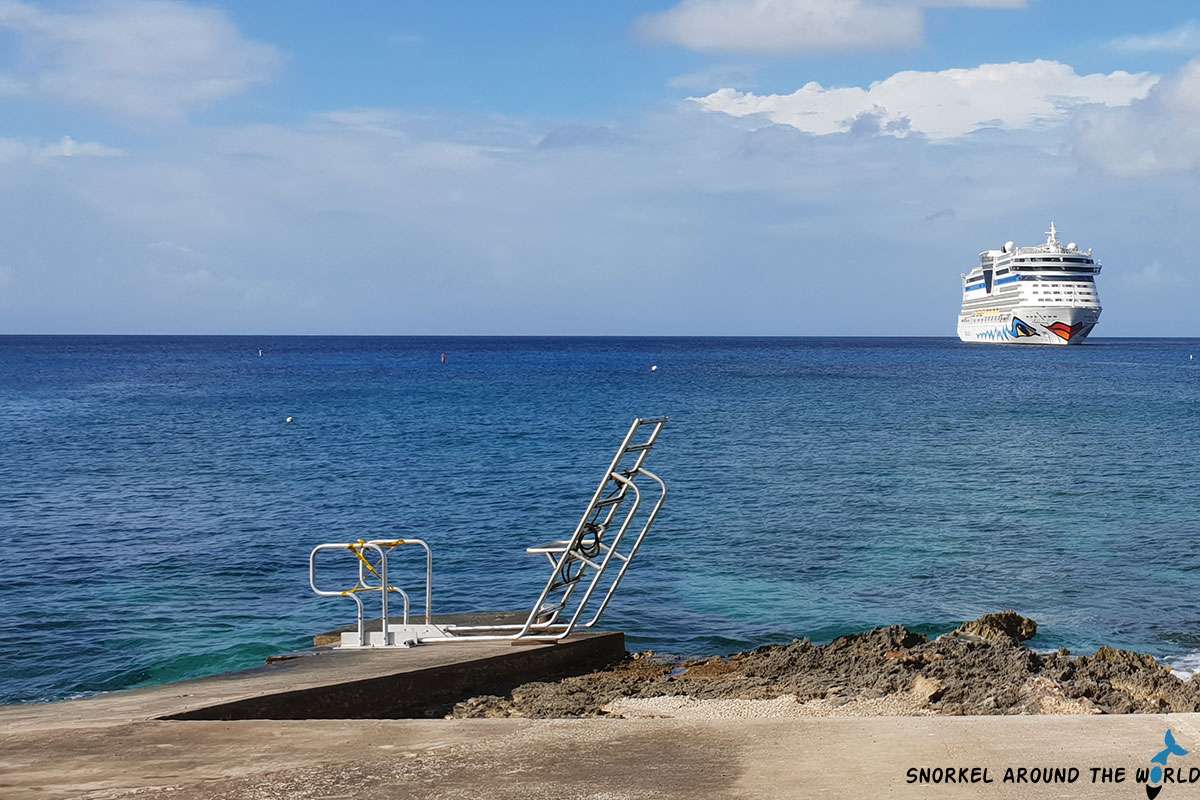
You’ll often see butterflyfish, parrotfish, sergeant majors, and sometimes barracuda. Nurse sharks rest in the rocky areas, and turtles are occasionally spotted here, too.

Eden Rock has an on-site dive shop with parking, lockers, and snorkel gear rental. There’s also a ladder for easy entry and exit, which makes it a good choice if you prefer straightforward shore access. The reef starts close to shore and drops gently, so it suits both beginners and confident snorkelers.
Swim details: Reef starts about 30 ft (10 m) from shore, depth ranges from 6-30 ft (2-9 m).
Devil’s Grotto – Swim-Through Caves & Tarpon Encounters
Devil’s Grotto is a deeper reef located just next to Eden Rock. While it’s mainly a dive site, the water here is so clear that snorkelers can still enjoy the coral walls, small caves, and swim-throughs from the surface.

The highlight is the schools of big tarpon that circle in the shaded areas, along with plenty of reef fish. You might also spot parrotfish, jacks, and the occasional turtle passing through.
To get there, enter the water at Eden Rock and swim about 165 ft (50 m) to the left. You’ll start seeing the caverns and overhangs that make this spot famous. The depth here is around 20-50 ft (6-15 m), so it’s best for confident swimmers who are comfortable in deeper water.
Swim details: Entry via Eden Rock ladder, swim 50 m left; depth 20-50 ft (6-15 m).
Sunset House – Mermaid Statue & Deeper Reef Snorkeling
Sunset House is a well-known shore diving spot that also works for snorkeling if you don’t mind deeper water. It has easy entry via ladders and on-site facilities, including a dive shop and a restaurant.
The reef begins close to shore in about 15 ft (4.5 m) of water and drops to 30-50 ft (9-15 m) as you go further out. The main attraction is a life-sized mermaid statue sitting at 50 ft (15 m), you can spot it from the surface on a clear day. The deeper sections also have sponges, soft corals, and fish like grouper, barracuda, and rays.
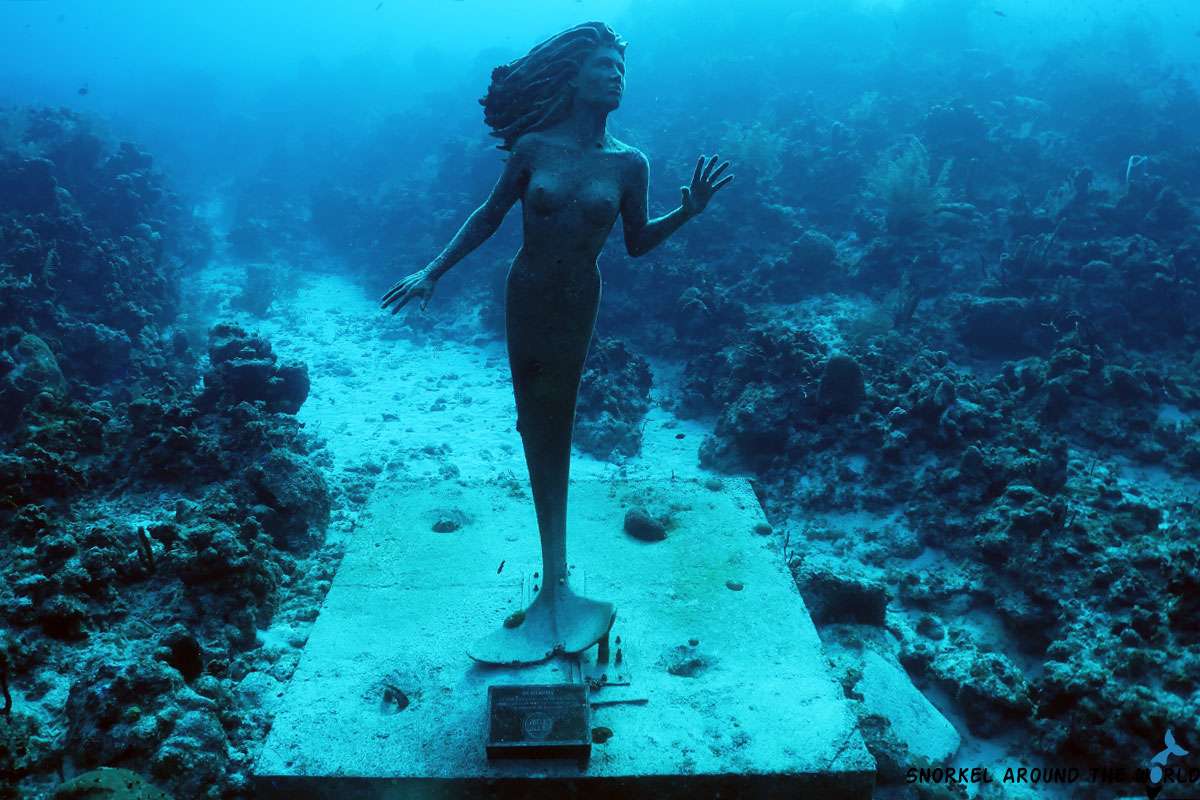
Most snorkelers stay in the shallower section, but stronger swimmers can venture out to see more of the reef. It’s best to bring a surface marker buoy here since small boats occasionally pass close to shore.
Swim details: Ladder entry from shore; shallow reef starts at 15 ft (4.5 m), deeper reef 30-50 ft (9-15 m).
Cheeseburger Reef – Shallow Reef Near George Town
Cheeseburger Reef gets its name from the Burger King right across the street, which makes it easy to find. It’s a short swim from shore, and the reef sits in shallow water, making it good for beginners and families.
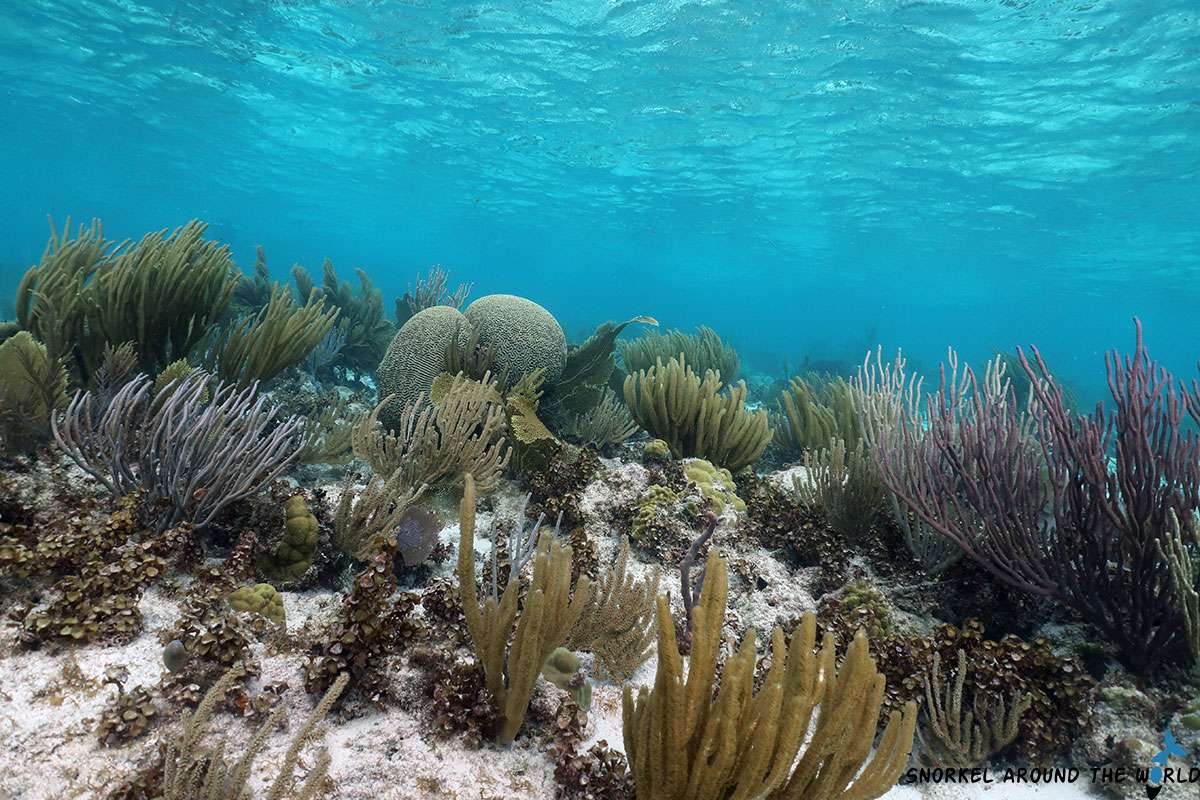
When we visited, we entered through the small beach access between Burger King and the Lobster Pot Dive Center, then swam about 100 ft (30 m) straight out. The coral heads start almost immediately, and we saw plenty of small reef fish like wrasse and sergeant majors darting around. We also came across a nurse shark resting in the sand, which was a nice surprise.
The water is usually calm here, but keep an eye out for boat traffic coming in and out of the harbor. A brightly colored snorkel vest or surface marker buoy is a good idea.
Swim details: Entry from beach access by Burger King, reef starts ~30 m from shore, depth 2-15 ft (0.5-4.5 m).
Smith Cove – Local Beach with Reef and Rock Formations
Smith Cove is a small public beach that locals love for its laid-back atmosphere. It’s a sandy cove framed by rock formations, with benches, showers, and toilets on-site. We found it a great place to relax between swims.

When we snorkeled here, the water near the shore was a bit cloudy due to the sand, but visibility improved once we reached deeper water. We swam out toward the marker buoy and found a reef with a mix of soft corals and colorful fish. Following the coastline in either direction was also worth it; we spotted a nurse shark resting under an overhang on the south side.
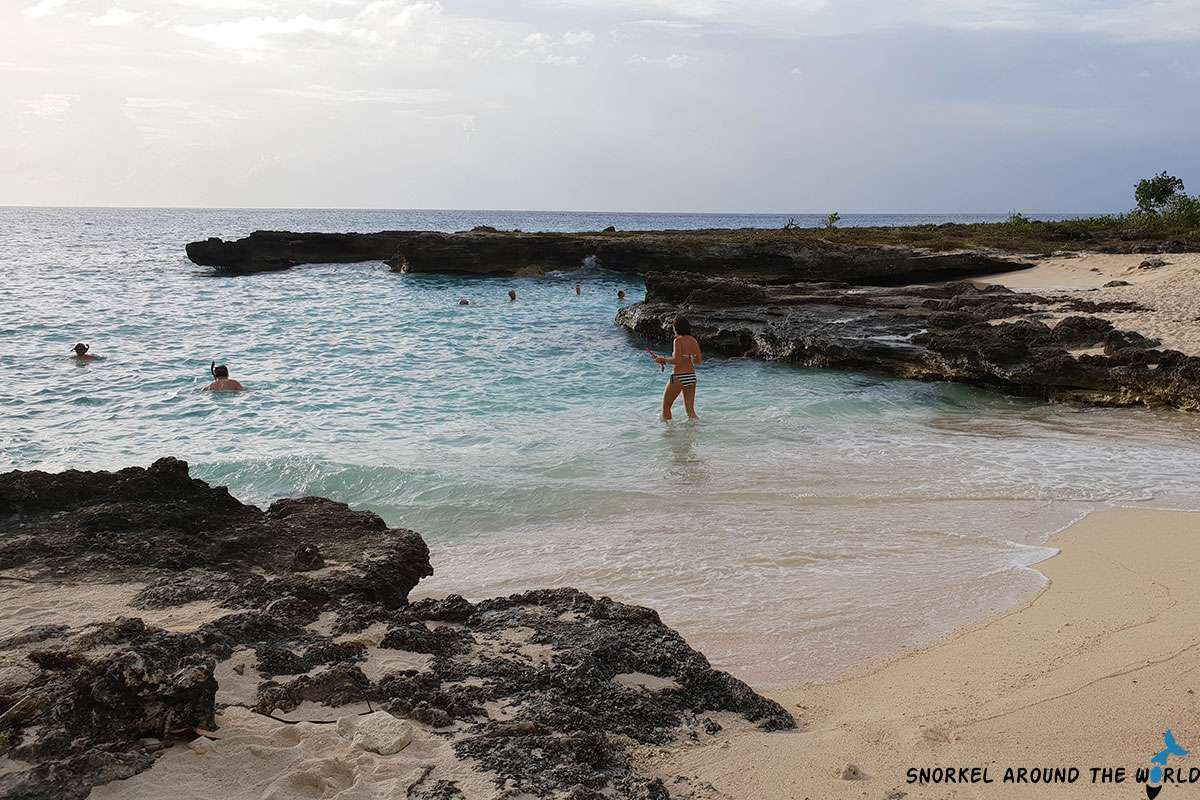
It’s an easy spot for casual snorkeling, and the facilities make it a convenient choice if you want to spend a few hours at the beach as well.
Swim details: Sandy beach entry; best reef around the buoy ~50 m from shore; depth 6-20 ft (2-6 m).
Spotts Beach – Reliable Turtle Sightings in Seagrass Meadows
Spotts Beach is one of the best places in Grand Cayman to see sea turtles while snorkeling. It’s a quieter beach about a 20-minute drive from George Town, with free parking, picnic tables, and a small restroom.
We visited in the morning, which locals recommended as the best time to catch turtles feeding in the seagrass. Within minutes of swimming out, we saw two green turtles grazing just below us. They were relaxed and didn’t seem bothered by our presence, but we kept our distance to avoid disturbing them.

The coral here isn’t as impressive as other sites, but you’ll still see small reef fish mixed in with the turtle grass. The waves and currents can be stronger than they look, especially past the seagrass, so weaker swimmers should stay closer to shore.
Swim details: Entry from sandy beach; turtles often 30-50 m from shore in 6-15 ft (2-5 m) depth.
Governors Beach – Patch Reef Off Seven Mile Beach
Governors Beach is one of the few places along Seven Mile Beach where you can reach a reef from shore. It’s a wide stretch of sand with calm, clear water and easy access, making it good for a quick snorkel if you’re staying nearby.
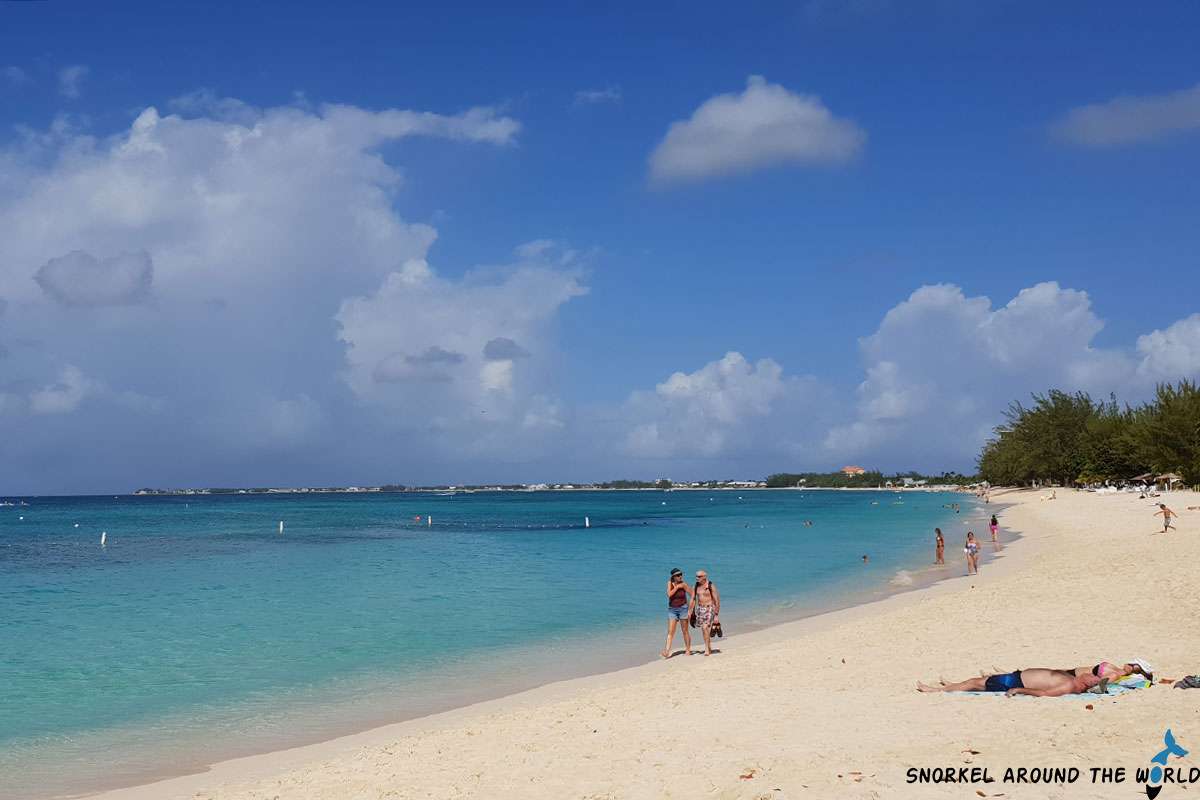
When we swam here, we headed straight out from the southern side of the public park. About 130-160 ft (40-50 m) offshore, we reached an isolated patch reef. It’s not very big, but we found a decent mix of coral heads and small tropical fish.
The reef is a bit harder to spot from the surface unless the sun is high, so it helps to know roughly where to aim before heading out. For a richer reef experience nearby, Cemetery Reef offers more variety, but Governors Beach is worth visiting if you want something close and easy.
Swim details: Entry from public park; reef starts ~40-50 m from shore; depth 6-12 ft (2-4 m).
Cemetery Reef – Marine Reserve with Healthy Coral and Fish Life
Cemetery Reef sits just off the quieter northern end of Seven Mile Beach, near a small cemetery that gives it its name. The beach here is peaceful, with soft sand and sea grape trees for shade.
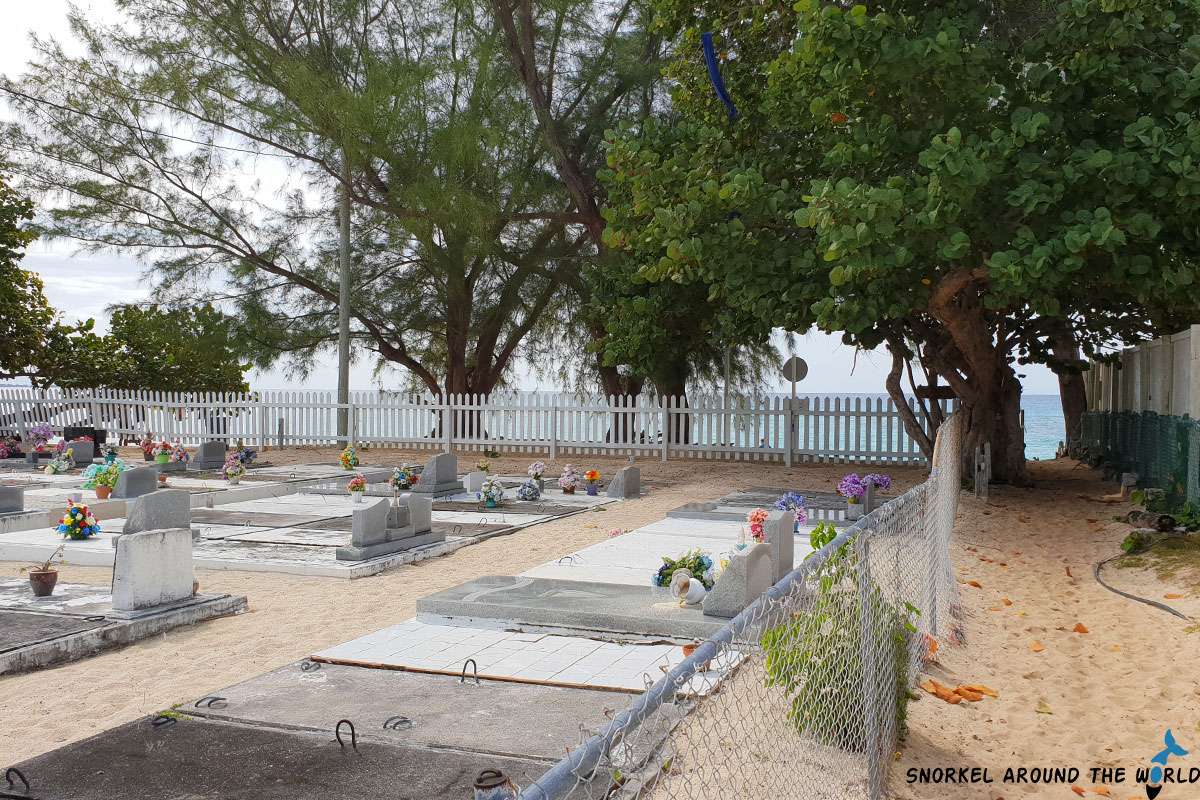
We entered from the public beach access and swam about 165 ft (50 m) to reach the first coral patches. Closer to shore, there are some artificial reef structures, but the natural reef further out is where the marine life starts to show. We saw schools of tangs, parrotfish, and even a turtle gliding by. The coral towers are healthy and colorful, with sandy channels in between.

It’s a protected area, so fishing isn’t allowed, which likely helps keep the marine life thriving. This spot is great for a relaxed snorkel and offers more variety than most reefs along Seven Mile Beach.
Swim details: Entry from beach access; main reef ~50 m from shore; depth 8-15 ft (2.5-5 m).
Turtle Reef – Drop-Off Wall and Abundant Marine Life
Turtle Reef is right next to Macabuca Bar & Grill in West Bay and is one of the most impressive shore-access sites on the island. The main draw here is the dramatic drop-off wall that starts about 100 ft (30 m) from shore.
When we snorkeled here, we entered via the ladder at the dive shop and swam straight out to the edge. The reef wall drops sharply into deep blue water, and even from the surface, you can see large sponges, sea fans, and plenty of fish cruising along the ledge. We spotted a hawksbill turtle, a stingray, and several barracuda during our visit.
The shallow area near shore also has coral heads with small reef fish, making it interesting even if you don’t go all the way to the wall. In winter, strong swells from the north can make conditions rough here, so it’s worth checking with the dive shop before heading in.
Swim details: Ladder entry at Macabuca; wall starts ~30 m from shore; depth ranges from 6 ft (2 m) in shallows to 30+ ft (9+ m) at the wall edge.
Colliers Beach – Quiet East End Swimming and Light Snorkeling
Colliers Beach is a peaceful public beach on the East End, far from the busier west side of the island. It has free parking, restrooms, shaded cabanas, and a small pier that makes getting in and out of the water easier.
We came here on a calm afternoon and enjoyed the relaxed atmosphere. The snorkeling isn’t as impressive as the island’s top spots, but there are small coral patches and sandy areas where you might see juvenile fish, a stingray, or even a squid or two. The water is shallow near shore, so it’s fine for beginners or for a quick swim to cool off.
For stronger swimmers, heading further out might reveal more coral, but it’s quite a distance before you reach anything substantial. This is more of a “beach day with a little snorkeling” kind of place rather than a dedicated snorkel destination.
Swim details: Entry from sandy beach or pier; shallow water near shore; small coral patches 30-50 m out, depth 3-8 ft (1-2.5 m).
Barefoot Beach – Secluded Cove with Wreck Nearby
Barefoot Beach is a small, quiet spot on the north shore, tucked between undeveloped lots along Queen’s Highway. It’s a good choice when the west side of the island is windy, as it can be more sheltered here.

When we visited, the water was calm and clear, with small coral formations scattered across the sandy bottom. We saw trumpetfish, porcupinefish, and a few schools of sergeant majors. The reef isn’t large, but it’s pleasant for a relaxed swim, especially for beginners.
If you swim to the right (east) along the shoreline, you may come across the remains of the Geneva Kathleen shipwreck. They’re not dramatic, but it’s an interesting extra to look for. Just note that in winter, sea grass and debris can wash up here.
Swim details: Beach entry from small sandy area; coral patches close to shore; wreck pieces roughly 60–80 m to the right in 6-15 ft (2-5 m) depth.
Babylon Reef – Remote Shallow Reef with Colorful Corals
Babylon Reef, also known as Queen’s Monument or Connolly Cove, is on the quieter north side of Grand Cayman. There’s no formal beach access or parking lot here, which means you’ll likely have the place to yourself.
We parked on the roadside near the monument and walked down a short path to the water. The reef starts close to shore in shallow water and has some of the brightest corals we saw on the island, along with plenty of reef fish. We also spotted a stingray resting in the sand just beyond the coral.
Because it’s a less-visited spot, there are no facilities, so it’s best to bring what you need and be prepared for a rocky shoreline entry. Calm conditions are important here; the site is more enjoyable when the water is flat.
Swim details: Rocky shoreline entry; reef starts ~20 m from shore; depth 3-10 ft (1-3 m).
Rum Point – Calm Waters and Easy Reef Access
Rum Point is on the island’s north side and is well known for its relaxed vibe. The area has a beach bar, picnic tables, and plenty of shade, making it a nice spot to spend the day. The water here is usually calm because it’s sheltered by a barrier reef, which also means the snorkeling is easy and safe.
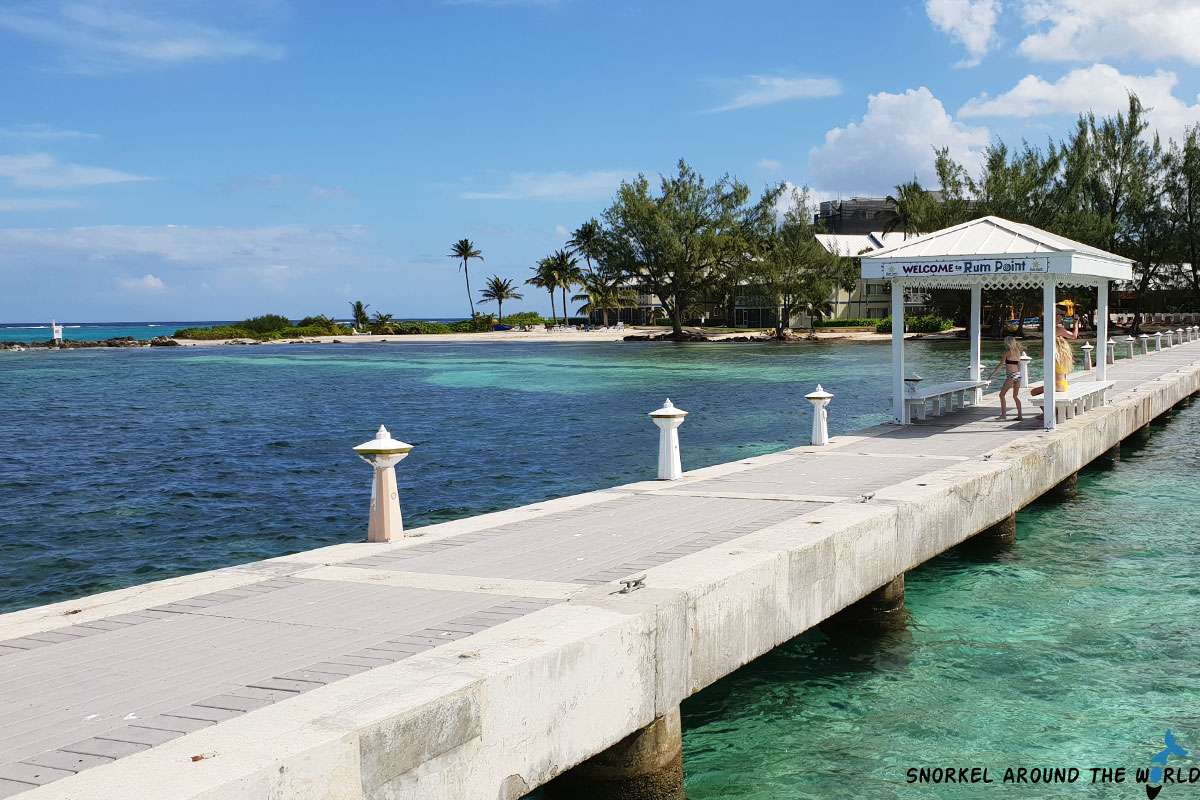
When we snorkeled here, we entered from the beach and swam to the right side of the pier. The coral gradually got denser as we headed toward the barrier reef, and we found large soft corals, colorful fish, and a few sea stars on the sandy bottom. We also saw a large stingray pass by, likely coming from the nearby Stingray City area.

It’s a good choice for all skill levels, and the shallow, protected water makes it especially family-friendly.
Swim details: Sandy beach entry; reef begins within 30 m, denser coral near barrier reef ~100 m out; depth 3-12 ft (1-4 m).
Cayman Kai Beach – Advanced Drift Snorkel Along the Barrier Reef
Cayman Kai Beach is at the northern tip of Grand Cayman and offers access to one of the island’s clearest and most vibrant reef sections. The barrier reef is a long swim from shore, so this spot is best for strong swimmers or those using a kayak.
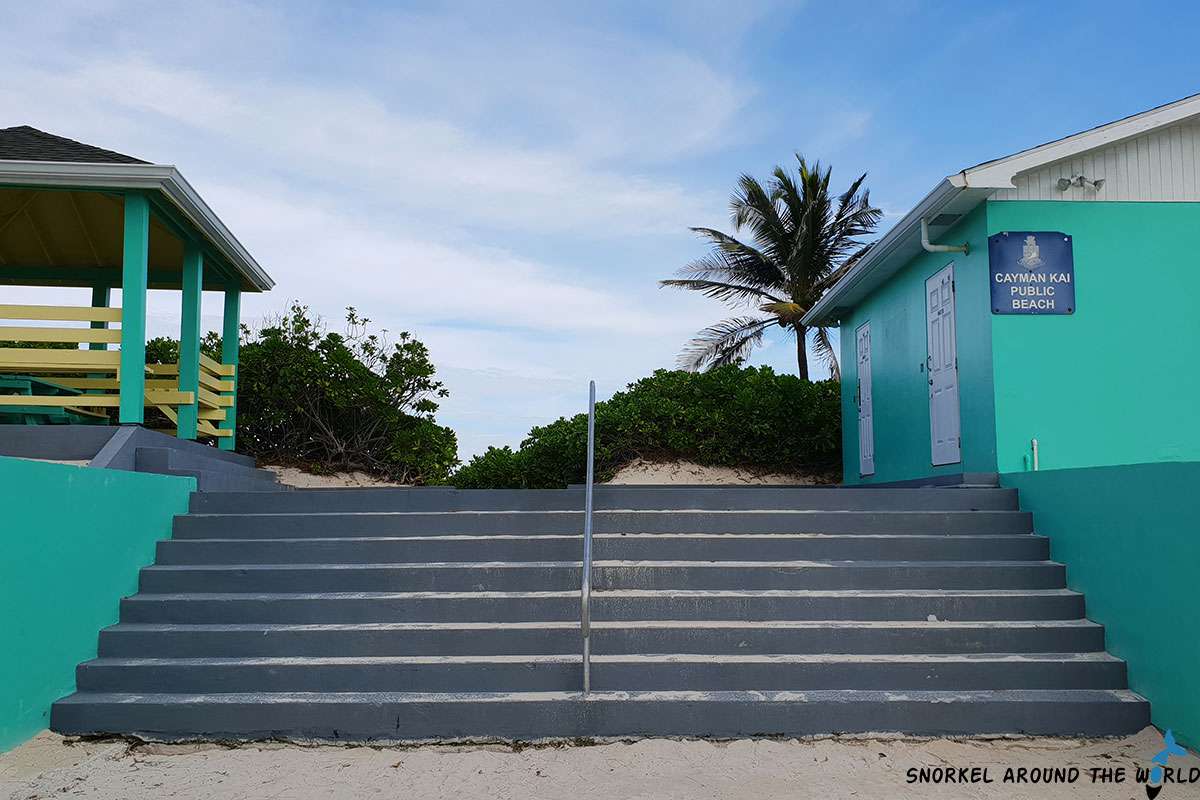
When we visited, we did a drift snorkel from Cayman Kai to Rum Point. We left our car near Rum Point, walked to Cayman Kai, and entered the water from the beach. After swimming about 300 m, we reached the reef, then let the gentle current carry us toward Rum Point. The coral was in excellent condition, with schools of blue tangs, angelfish, and even a couple of eagle rays gliding by.

This route takes about two hours in the water, so a surface marker buoy is essential, and you should only attempt it in calm weather. It’s one of the most rewarding snorkels on the island if you’re up for the swim.
Swim details: Beach entry; barrier reef ~300 m from shore; depth 6-20 ft (2-6 m); strong swimming required.
Starfish Point – Shallow Bay with Dozens of Sea Stars
Starfish Point is a calm, shallow beach on the north side of Grand Cayman, famous for the red cushion sea stars that live just offshore. It’s about an hour’s drive from Seven Mile Beach, so it’s not as busy as the main tourist areas.
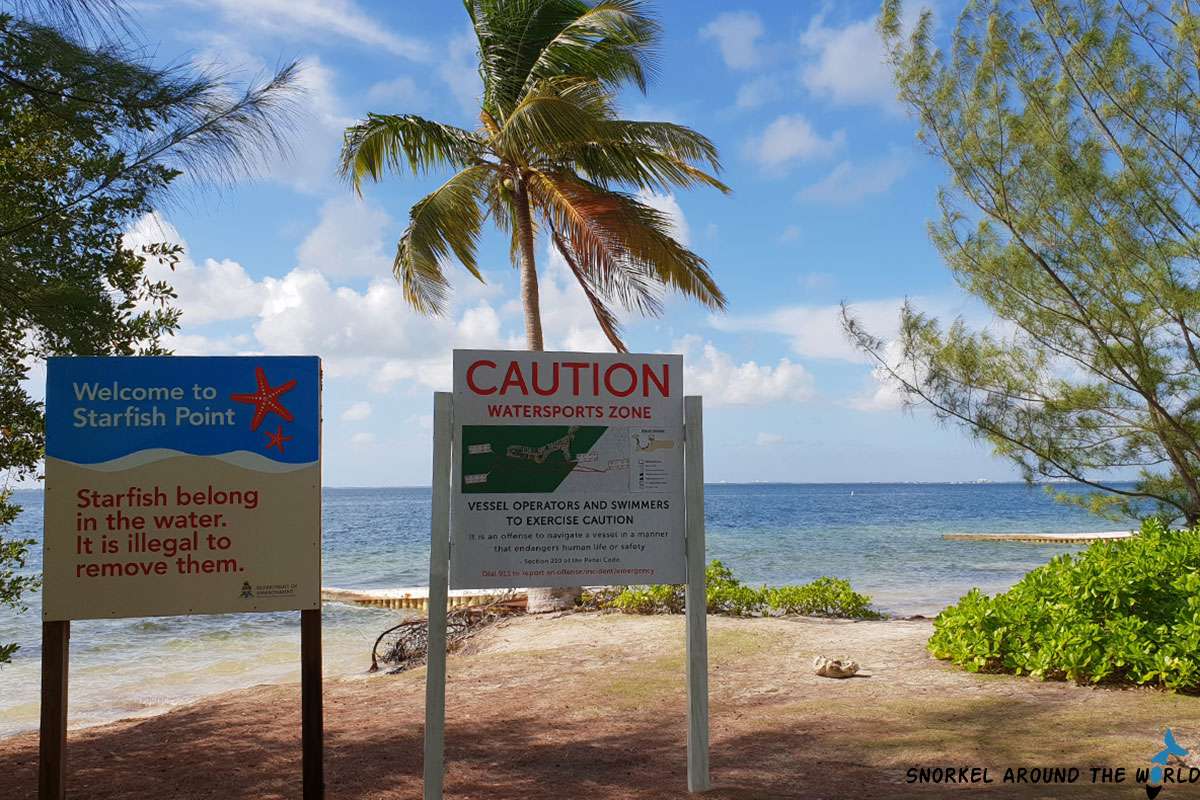
We arrived early in the morning before the tour boats came in and found dozens of starfish scattered across the sandy bottom in waist-deep water. The water is usually very clear, so it’s easy to spot them without diving down.
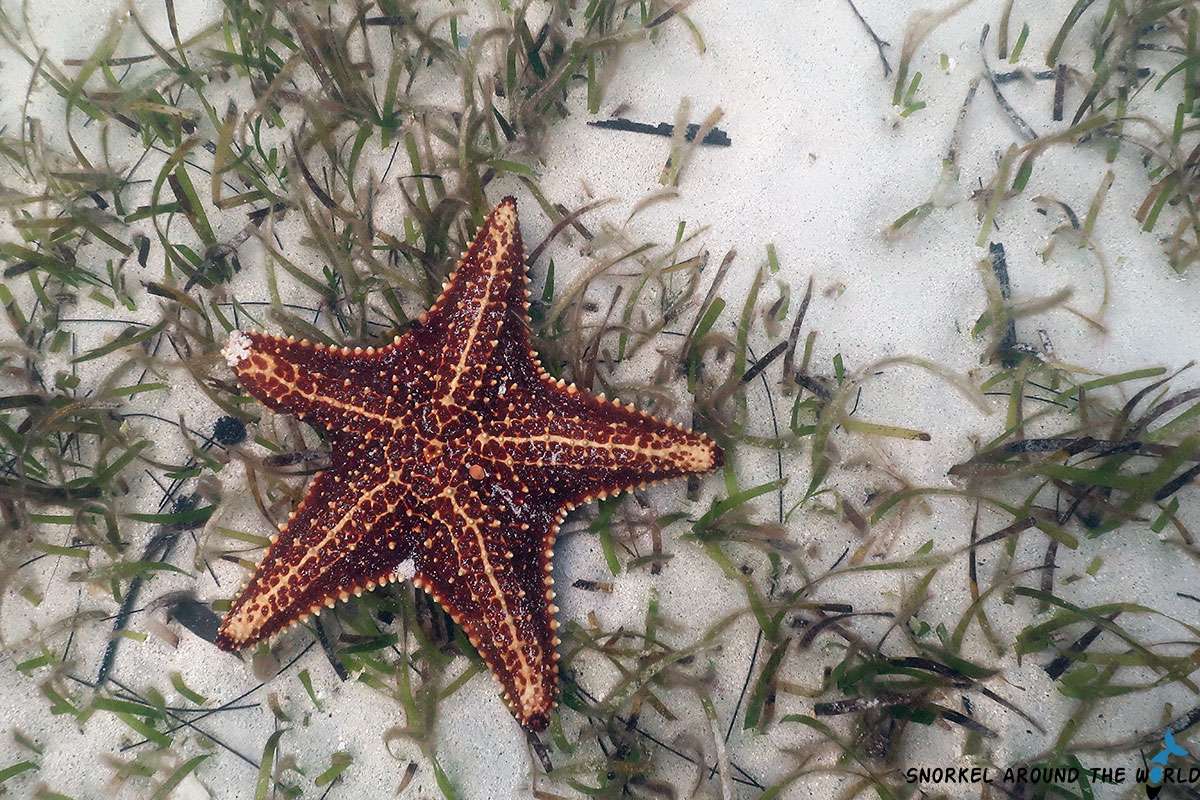
It’s important to leave the starfish in the water; taking them out, even briefly, can harm them, and it’s illegal in Grand Cayman. This is more of a gentle, wading experience than a full snorkeling site, but it’s worth the trip if you’re already exploring the Rum Point area.
Swim details: Sandy beach entry; starfish in 2-5 ft (0.5-1.5 m) of water within 10-20 m of shore.
Stingray City – Shallow Sandbar with Friendly Rays
Stingray City is one of Grand Cayman’s most famous attractions, a shallow sandbar in North Sound where southern stingrays gather. The only way to get here is by boat, and most tours also include a stop at nearby Coral Gardens.
We didn’t take part in the feeding activities, but we did snorkel in the area and saw several large rays swimming past. The sandbar is only about 3-4 ft (1-1.2 m) deep, so you can stand in the water while watching the stingrays glide by. The water clarity here is excellent, making it a great place for underwater photos.
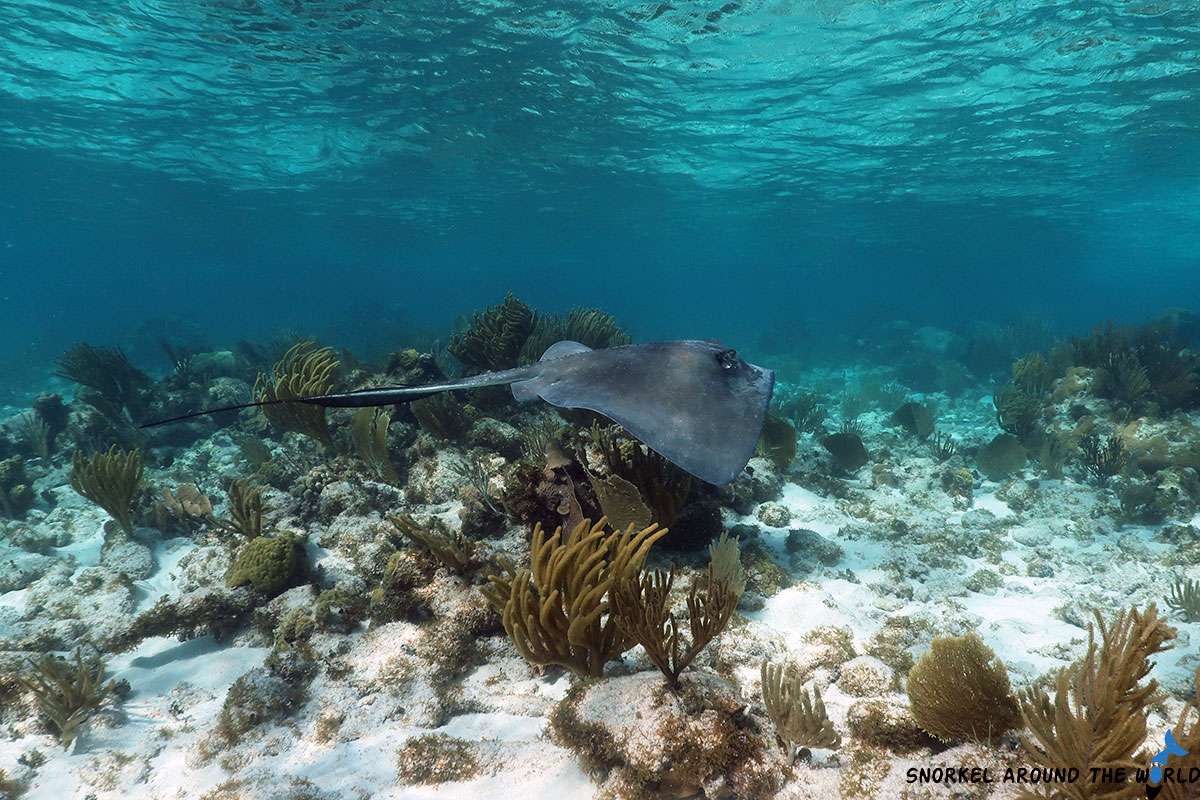
It’s worth noting that the stingrays here are used to people, so they may approach closely. If you prefer a more natural encounter, you can sometimes see them while snorkeling at Rum Point or other spots along the north coast.
Swim details: Access by boat only; depth 3-6 ft (1-2 m); typically part of a half-day tour.
Besides these spots where you find mainly reefs and sea creatures, the island has excellent shipwrecks too suitable for snorkeling! We write about them in a separate guide; check out our Grand Cayman shipwrecks article! Also, watch our video to get an impression of what to expect from snorkeling in Grand Cayman!
Useful Tips for Snorkeling in Grand Cayman
If snorkeling is your main priority when booking a vacation in Grand Cayman, you should consider a few factors to get the most out of your trip. Let us help you with tips on the best time to visit the island, where to stay, and how to get around.
Best Time of Year for Snorkeling
Snorkeling in Grand Cayman is possible year-round, but the best conditions are usually from December to April, when the weather is dry and the seas are calm. This is also the busiest season, so popular beaches and parking areas can fill up quickly.
From May to November, the island is quieter and hotel prices are lower, but you may get more rain and occasional storms. If you want fewer crowds but still good water visibility, late April to early June and September to early November are good choices.
Water Visibility, Temperature, and Safety Conditions
Grand Cayman is known for its clear water, visibility is often over 100 ft (30 m) and can reach 150 ft (45 m) on calm days. The sea temperature stays warm all year, usually between 78-86°F (25-30°C), so you won’t need a wetsuit unless you’re snorkeling for long periods in the cooler months.

Most snorkeling spots are safe in normal conditions, but strong winds or swells can make certain areas rough, especially on the north and east coasts in winter. If one side of the island is choppy, you can usually find calmer water on the opposite side.
For comfort and protection, we recommend wearing a rash guard and using reef-safe sunscreen. In rare cases, you might come across small jellyfish or experience “sea itch,” so covering your skin is a good precaution.
What to Pack for Snorkeling
If you have your own snorkel gear, bringing it will save rental costs and ensure a comfortable fit. A good set should include a mask, snorkel, and fins. For extra comfort and safety, pack:
- Rash guard or swim shirt – for sun protection and to reduce skin irritation
- Reef-safe sunscreen – avoid products with oxybenzone or octinoxate
- Snorkel vest or flotation belt – useful for beginners or long swims
- Surface marker buoy – important at sites with boat traffic
- Underwater camera or GoPro – to capture marine life and reef details
If you prefer to travel light, most dive shops and some beachside resorts rent out quality gear by the day or week.
Getting Around the Island
The easiest way to reach Grand Cayman’s best snorkel spots is by renting a car. Most major rental companies have desks at the airport, and driving is straightforward once you remember that traffic keeps to the left. Parking is free at most beaches and public access points, though some areas in George Town may have paid parking.
Public transport is an option if you’re staying near the main routes. Small minibuses run from the George Town bus terminal to various parts of the island and are inexpensive, but they don’t stop directly at every snorkel site. Taxis are available but can be costly for longer distances.
If you’re visiting on a cruise, many good snorkel spots like Eden Rock, Cheeseburger Reef, and the Wreck of the Cali are within walking distance of the port.
Where to Stay
If you want to be close to restaurants, shops, and some easy-access snorkel spots, Seven Mile Beach is the most convenient area. You’ll find a mix of hotels, condos, and resorts, and you can snorkel at places like Governors Beach and Cemetery Reef without driving far.
For a quieter stay, look at West Bay, East End, North Side, or Rum Point. These areas have fewer crowds, more local guesthouses and villas, and good access to calm beaches. Just keep in mind that you’ll likely need a rental car for groceries and getting to different snorkel sites.
Snorkel Spots Near the Cruise Port
If you’re arriving in Grand Cayman by cruise ship, you can still enjoy some great snorkeling without booking a tour. Several spots are within walking distance of the port in George Town:
- Eden Rock – Just a few minutes’ walk, with easy ladder access and plenty of fish.
- Devil’s Grotto – Next to Eden Rock, deeper water with caves and schooling tarpon.
- Cheeseburger Reef – A short walk north, shallow reef with colorful coral heads.
- Wreck of the Cali – Historic shipwreck in shallow water, good for photography.
- Wreck of the Gamma – Small intact wreck partly visible from the surface.
All of these can be done in a couple of hours, making them ideal for a short port day.
FAQs About Snorkeling in Grand Cayman
Inspired? Pin it!
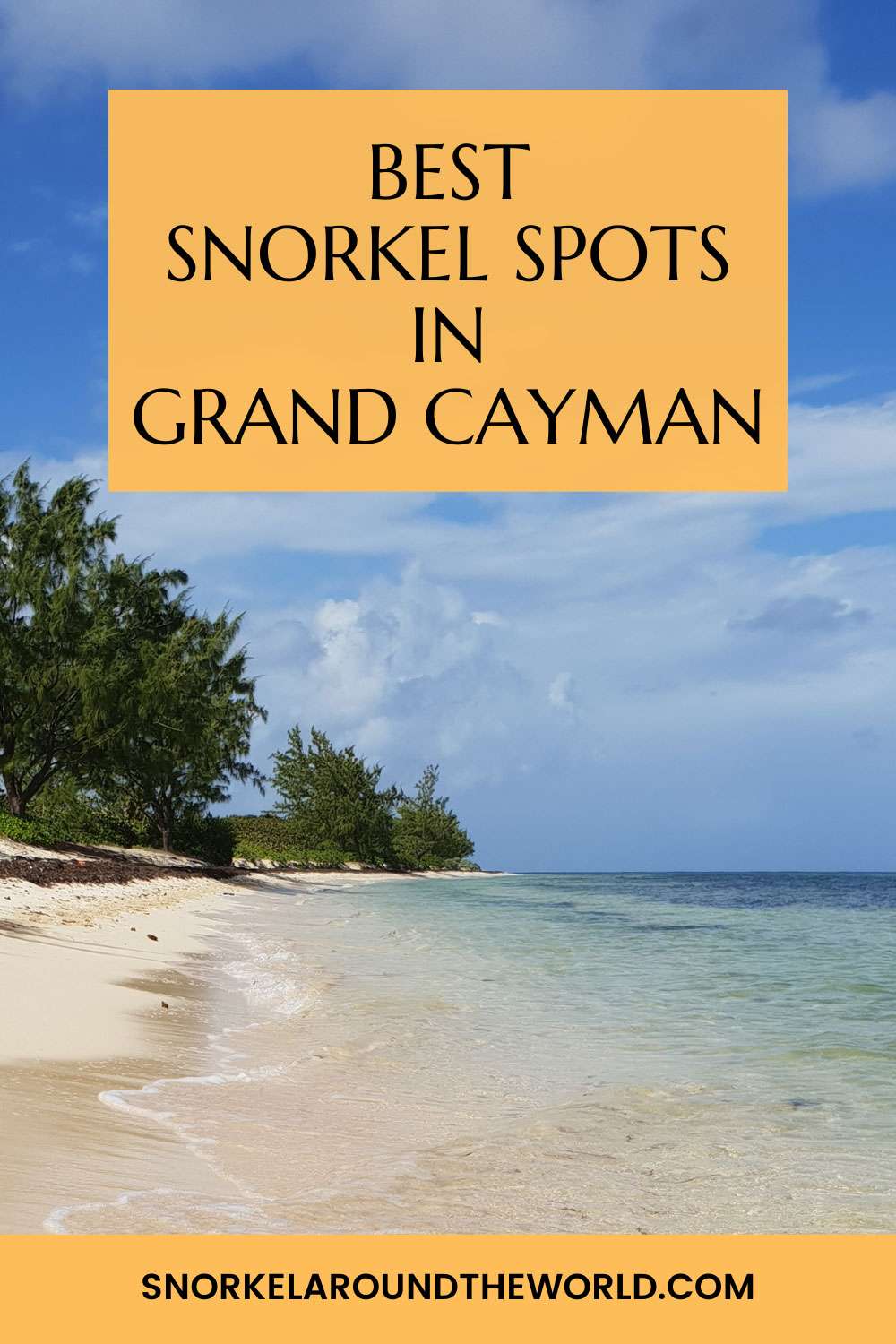



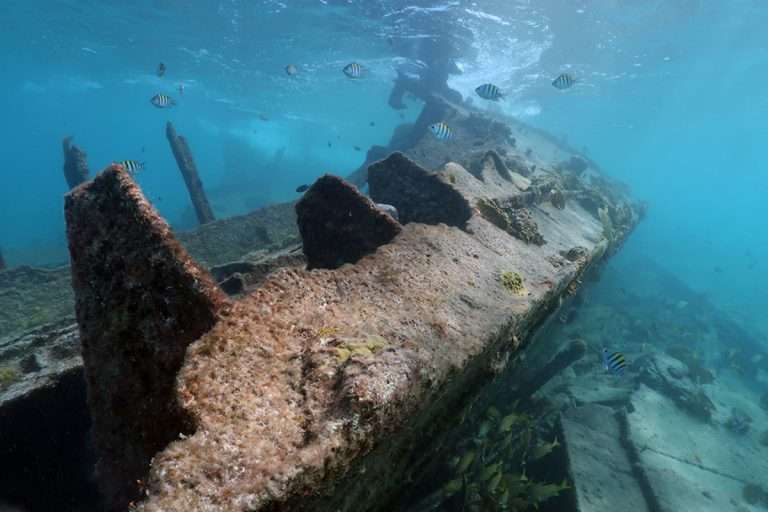


Thank you! This is the most helpful post of all the sites I looked ay